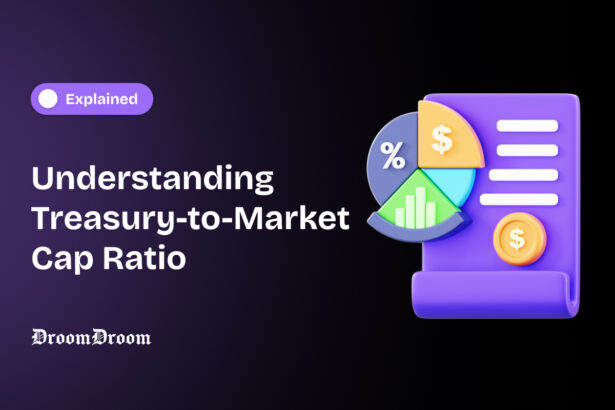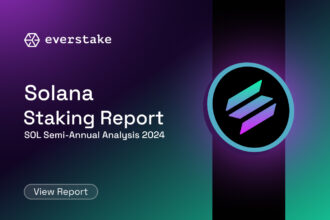The Treasury to Market Cap Ratio measures the amount of crypto in a Digital Asset Treasury relative to its market value. The ratio is used to gauge the amount of crypto the treasury owns for each dollar of investment.
In this article, we will explore the metric, understand it with an example, and also discuss its significance and limitations.
What are Digital Asset Treasuries? Types, Significance, and Future
Definition
The Treasury to Market Cap Ratio measures the total size of the treasury with respect to the fully diluted market capitalization of the company. The ratio measures the amount of crypto assets in the treasury with respect to the amount of funds invested in its shares (i.e., the market cap).
Alternatively, this can also be understood as the percentage of crypto in a treasury with respect to its market cap.
If a treasury has a ratio of 59% (which is also 0.59), then it means it has 59% in assets as compared to its market cap.
While using the ratio, you will find three situations:
- If the ratio is 1, then for each $1 invested in the company, you would own $1 worth of crypto.
- If the ratio is more than 1, then for each dollar invested in the company, you would be entitled to crypto that is worth more than $1. This is an undervalued company.
- If the ratio is less than 1 (the most likely real-life scenario), then you would own less than $1 worth of crypto for each dollar invested.
In real life, the third situation is most likely because companies incur some expenses to manage the treasury, which affects their total crypto holdings.
Example
Assume a company’s Bitcoin Treasury has 1000 Bitcoins, and has 10,000 shares of $100 each. Then the size of the Treasury comes to be $100 million, and the market cap of the company comes to be $1 million.
Treasury to Market Cap Ratio
= Total Treasury Size ÷ Total Market Cap
= $100 million ÷ $10 million
= 10 or 1,000%
In this case, for every $1 invested in the company, an investor owns $10 worth of Bitcoins. Hence, the treasury is undervalued as the investor gets a 10x profit upon purchase.
Obviously, the example provided does not exist in real life, where the Treasury to Market Cap Ratio is around 1, mostly less than 1.
The Future of Bitcoin Treasuries: The Perpetual Debt Question
Significance
There are two different meanings for the same ratio for crypto-only treasuries (like Strategy) and diversified treasuries (like Tesla Inc).
Denotes Efficiency in Acquisitions (for Crypto Only Treasuries)
The Treasury to Market Cap Ratio is used to obtain the percentage of assets a company has relative to its market capitalization.
If the company treasury has a ratio closer to 1, it means it has a decent amount of assets. It also means that the company has been efficiently doing its crypto acquisitions.
If the ratio is far less than 1 (say 0.55), then the company has too few assets and the amount of crypto per share is way diluted. This denotes bad efficiency, i.e., the company has burnt too much cash to acquire few assets.
Special Case: However, in some scenarios where the treasury is popular, like Strategy, the ratio could get lower because people are willing to pay more for the treasury shares, expecting share price appreciation.
In very few cases, would you find a ratio greater than 1. In such scenarios, the treasury shares generally have a very low demand, either due to their bad reputation or because they are relatively new.
Degree of Asset Allocation to Crypto
The ratio also indicates the degree of crypto adoption as a part of the company’s treasury. The higher the asset allocation to crypto, the more it indicates a growing demand. Similarly, a low Treasury to Market Cap ratio indicates the company is either diversified or has a lesser intention of adopting cryptocurrencies for its treasury.
Are Bitcoin Treasuries Heading Towards a Bubble like the Dot Com or Housing Crisis?
Limitations
Volatility Dependent Metric
The Treasury to Market Cap Ratio is not a comprehensive metric and only shows how much the treasury owns relative to its market cap.
In some cases, due to volatile markets, the share price may plummet or rise too sharply.
A plunge in share price could lift the ratio above 1, making the company attractive to buy even if it might be of low quality.
Similarly, a quick rise in share price could shoot down the ratio well below 1, indicating a too-premium price or unsustainable valuations, even if the company’s vitals are normal otherwise.
Does Not Suit Diversified Companies
For companies like Tesla, which have a very small allocation to cryptocurrencies, the metric shows a very low Treasury to Market Cap Ratio. Low ratio typically indicates bad asset quality, which is not true as Tesla’s treasury has a significant amount of other assets as well.
Why Are Ratios Important in Evaluating Digital Asset Treasuries?
With hundreds of Digital Asset Treasuries worldwide, it becomes difficult to compare them in a summary manner. Critical ratios like Net Asset Value (NAV), Market Net Asset Value (MNAV), and Treasury to Market Cap help investors make summary comparisons between different treasuries in a very short time.
Comparing Net Asset Value (NAV) and Market NAV (MNAV) in Crypto Treasuries
For example, take a look at the list of Bitcoin Treasuries. With just 1 ratio (say MNAV), you can easily compare which treasury has the best quality of assets.
If it were not for the ratio, the same comparison would have taken days with investors exploring each balance sheet and making endless comparisons.




















